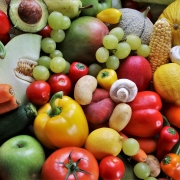Toxic Foods
Toxic foods abound in the produce aisle. It’s good to know this when you are trying to get more fruits and veggies into your diet. Some of them can have harmful effects on the body.
According to the Environmental Working Group (EWG)”One particularly dangerous pesticide is chlorpyrifos, which scientists have definitively linked to brain damage in children and fetuses.”
EWG puts out a list every year of the most toxic and the cleanest foods. The toxic list includes the foods with the most pesticides. The list is called The Dirty Dozen. They recommend getting these foods organically grown whenever possible, to avoid the huge overload of chemical sprays. Of course there are other foods that are also highly sprayed (which you can see on the EWG website), but these twelve are the ones we should avoid eating the most if conventionally produced.
This list includes:
- Strawberries
- Spinach
- Kale-collard-mustard greens
- Nectarines
- Apples
- Grapes
- Bell and hot peppers
- Cherries
- Peaches
- Pears
- Celery
- Tomatoes
EWG also has a list called The Clean 15. These are the foods that have the least pesticides. They can be eaten more freely when grown conventionally.
The list includes:
- Avocados
- Sweet corn
- Pineapple
- Onions
- Papaya
- Sweet peas, frozen
- Asparagus
- Honeydew melon
- Kiwis
- Cabbage
- Mushrooms
- Cantaloupe
- Mangoes
- Watermelon
- Sweet potatoes
Note: Some sweet corn and papayas are genetically modified, so it is still best to buy them organic.
How To Start Eating Cleaner
In addition to buying organic foods, you can buy produce from local farmers markets and produce stands where the farmers either don’t spray their crops or only spray them lightly as needed. Another option is to grow some of your own food. There’s nothing like a home-grown tomato! If insects start to eat your plants, you can purchase natural sprays at nurseries, such as those formulated with neem or chrysanthemum leaves. Or you can make your own sprays with ingredients such as essential oils, garlic, and cayenne pepper.





Leave a Reply
Want to join the discussion?Feel free to contribute!